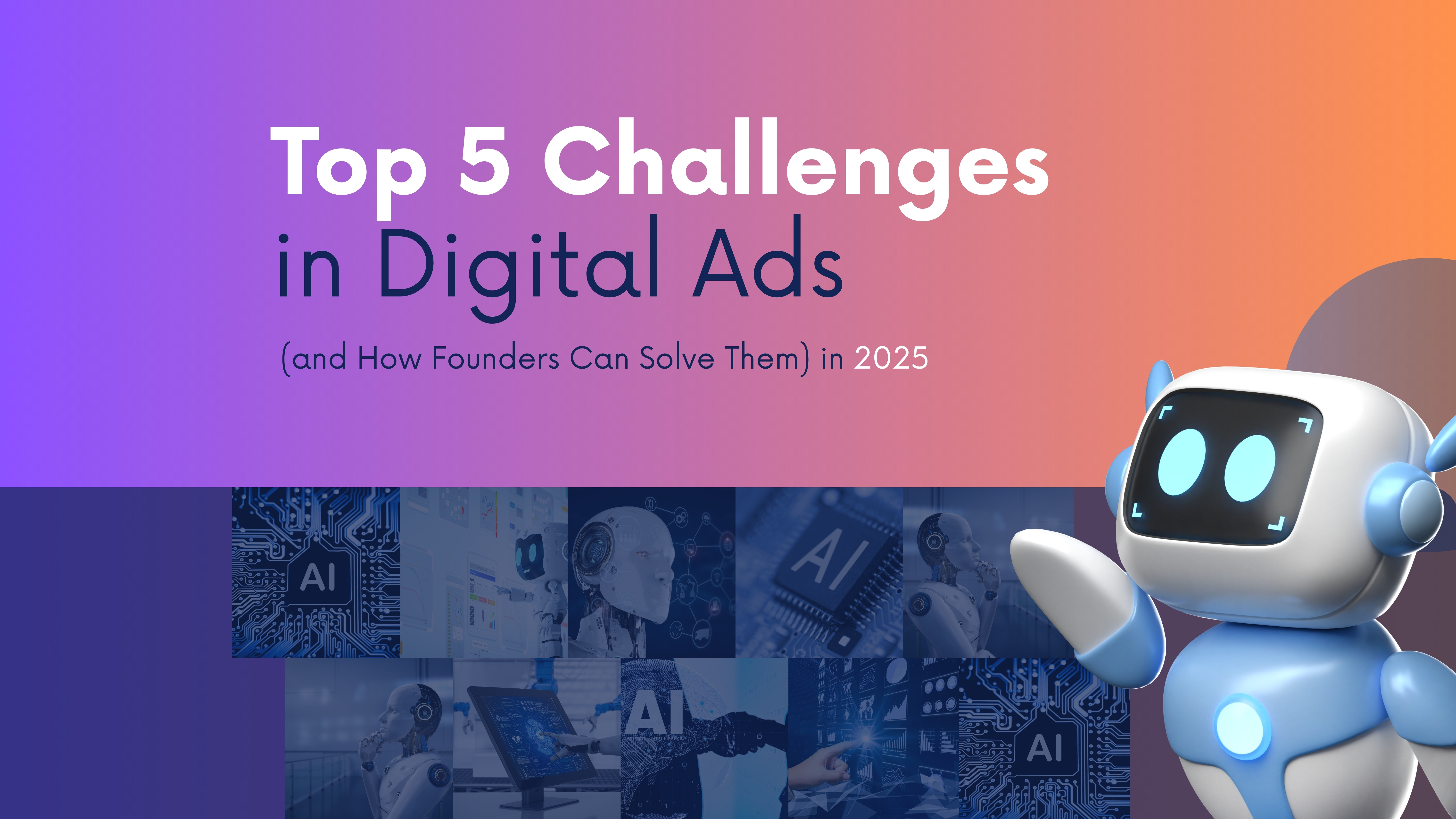Top 5 Challenges in Digital Ads (and How Founders Can Solve Them) in 2025

Top 5 Challenges in Digital Ads (and How Founders Can Solve Them) in 2025
Digital advertising is a cornerstone for founders looking to grow their businesses, but it’s not without obstacles. Rising costs, audience fatigue, privacy regulations, platform complexity, and performance tracking can drain resources and overwhelm solopreneurs. In 2025, artificial intelligence (AI) is transforming how founders tackle these challenges, enabling small businesses to compete with larger players.
1. Rising Ad Costs and Budget Constraints
Challenge: Ad costs are climbing across major platforms, with average Cost Per Click (CPC) ranging from $0.80 on Facebook to $3.20 on LinkedIn in 2025, according to industry benchmarks. For founders with limited budgets, competing with big-budget brands feels daunting, often leading to inefficient ad spend or missed opportunities.
 Solution: AI-powered tools optimize budgets for maximum impact. Platforms like Google Ads’ Smart Bidding and Nyra AI 4 use predictive analytics to forecast high-ROI channels and allocate funds effectively. Adopt the AI-enhanced 60/25/15 rule: 60% of your budget for proven campaigns, 25% for testing new strategies, and 15% for experimental AI tools. These tools analyze historical data to minimize wasted spend, ensuring every dollar counts.
Solution: AI-powered tools optimize budgets for maximum impact. Platforms like Google Ads’ Smart Bidding and Nyra AI 4 use predictive analytics to forecast high-ROI channels and allocate funds effectively. Adopt the AI-enhanced 60/25/15 rule: 60% of your budget for proven campaigns, 25% for testing new strategies, and 15% for experimental AI tools. These tools analyze historical data to minimize wasted spend, ensuring every dollar counts.
Pro Tip: Start with a modest $10-30/day budget to gather performance data, then let AI adjust spend dynamically to reduce Customer Acquisition Cost (CAC) by up to 15%. Monitor metrics like CPC and ROI weekly to refine your approach.
2. Ad Fatigue and Declining Engagement
Challenge: With consumers exposed to thousands of ads daily, ad fatigue is a growing issue, resulting in declining Click-Through Rates (CTRs), which average 2-3% for display ads. Generic ads struggle to stand out, leading to low engagement and wasted budgets for founders.
Solution: AI-driven hyper-personalization combats ad fatigue. Tools like Midjourney generate dynamic visuals, while ChatGPT crafts tailored ad copy based on user behavior and preferences. Platforms like Facebook’s Advantages and TikTok’s Smart Creative automate A/B testing, creating thousands of ad variations and prioritizing those with the highest engagement. For example, a skincare brand can show anti-aging ads to older audiences and acne solutions to younger ones, all in real-time.
Pro Tip: Rotate ad creatives weekly to keep content fresh. Use AI to analyze audience data and suggest personalized CTAs, boosting CTR by 20-30% through relevance and variety.
3. Privacy Regulations and Cookie Deprecation
Challenge: Stricter privacy laws like GDPR and CCPA, combined with the phase-out of third-party cookies in 2025, limit traditional targeting methods. Founders risk non-compliance or reduced audience reach, making it harder to deliver relevant ads without violating user privacy.
Solution: Privacy-first AI tools ensure compliance while maintaining targeting accuracy. Google’s Privacy Sandbox and Facebook’s Conversions API use federated learning and on-device processing to personalize ads without relying on invasive data collection. These tools analyze anonymized user signals to deliver relevant ads, preserving trust and performance.
Pro Tip: Implement Conversions API for enhanced tracking and use AI to exclude low-value audiences, cutting wasted spend by 10-15%. Stay updated on privacy regulations to ensure your campaigns align with 2025 standards.
4. Platform Overload and Management Complexity
Challenge: Managing campaigns across platforms like Google, Facebook, LinkedIn, and TikTok is time-intensive, especially for founders without marketing teams. Disparate dashboards, conflicting metrics, and manual adjustments create inefficiencies and overwhelm.
Solution: Cross-platform automation tools streamline management. Solutions like Nyra AI 4 and HubSpot’s ad suites integrate data from multiple channels, providing unified dashboards for metrics like CTR, CPA, and ROI. AI automates bid adjustments, pauses underperforming ads, and shifts budgets to high-performing platforms, saving hours of manual work.
Pro Tip: Use a single dashboard to track performance across platforms. Schedule weekly reviews to assess AI recommendations and focus on strategic decisions like campaign messaging.
5. Measuring and Optimizing Campaign Performance
Challenge: Founders often lack the expertise to track and optimize campaigns effectively. Without clear insights into metrics like CTR or CAC, it’s challenging to identify what’s working or how to improve ROI, leading to suboptimal results.
Solution: AI-driven analytics simplify performance tracking. Tools like Nyra AI 4 offer anomaly detection, flagging underperforming ads, while Google Ads’ Performance Planner forecasts outcomes based on historical data. AI optimizes bids and targeting in real-time, providing actionable insights to enhance campaign efficiency.
 Pro Tip: Aim for a CTR of 3-5% and a CAC 20% below industry averages. Use AI-generated reports to focus on high-level strategy, such as refining offers, while automation handles tactical optimizations.
Pro Tip: Aim for a CTR of 3-5% and a CAC 20% below industry averages. Use AI-generated reports to focus on high-level strategy, such as refining offers, while automation handles tactical optimizations.
Conclusion
In 2025, digital advertising challenges rising costs, ad fatigue, privacy restrictions, platform complexity, and performance tracking can hinder founders’ success. However, AI-powered solutions level the playing field. By leveraging tools like Nyra AI, Google’s Smart Bidding, and Facebook’s Advantage+, founders can optimize budgets, personalize ads, ensure compliance, streamline management, and boost ROI without a marketing team. Start small, embrace automation, and focus on strategy to turn these challenges into opportunities for growth. With AI, digital advertising becomes a powerful, accessible tool for every founder.